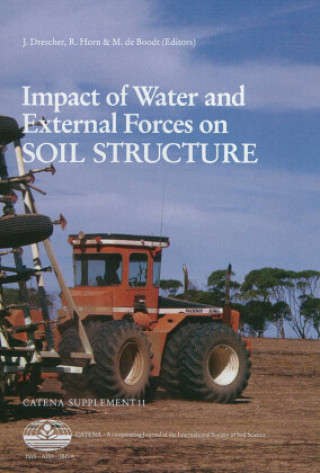
Doručení
Nákupní rádce





Nehodí se? Vůbec nevadí! U nás můžete do 30 dní vrátit
 Dárkový poukaz
V libovolné hodnotě
Dárkový poukaz
V libovolné hodnotě
S dárkovým poukazem nešlápnete vedle. Obdarovaný si za dárkový poukaz může vybrat cokoliv z naší nabídky.
Impact of Water and External Forces on Soil Structure
 Angličtina
Angličtina
 201 b
201 b
30 dní na vrácení zboží
Mohlo by vás také zajímat


The relationship between the composition of a soil, its fabric, water content, and the external forces on it is of great importance for both agriculture and civil engineering. External forces acting on a soil generally reduce the amount of pore space, thus compacting the soil. The degree of compaction not only depends on the size and kind (static or dynamic) of load, but also on the soil composition, soil fabric, and degree of saturation with water. The soil fabric results from the formation of aggregates from individual grains. The binding forces required for this process are supplied by mineral and nonmineral components. This binding, especially that of the mineral components, may be reduced or completely neutralized if water intrudes. This may cause the partial or complete breakdown of the soil fabric and thus also increase the susceptibility of the soil to erosion. Well-developed soils have a good balance between voids and particles and have a high water storage capacity; accordingly, these types of soils offer the most favorable conditions for vegetation. They are also less susceptible to erosion. Therefore, the stability of the soil structure must be increased to obtain optimum conditions for agricultural purposes. Breakdown of the structure, artificial soil compaction, etc., therefore, must be eliminated by mechanically breaking up the soil. In civil engineering, however, a high load-bearing capacity and a low compressibility of the soil is required. This objective is achieved by reducing the pore space in the soil by systematic compaction. The degree of compaction depends on the type of soil, its water con- tent, and the method of compaction. These aspects are of great economic relevance for both agriculture and civil engineering, although the objectives are quite the opposite of each other. Therefore, considerable research has been conducted in both fields in these aspects. Although both sides use the investigation methods and research results of the other in their work, satisfactory cooperation has not yet been achieved. Disregarding the objectives (to avoid compaction in agriculture; to achieve as high a degree of compaction as possible in civil engineering), this may be due to the fact that both disciplines use the term "soil" for two types of materials that behave differently. Soils in the engineering sense are chiefly of mineral origin. Organic soils or soils that contain a rather high percentage of organic matter, as is typical of agricultural soils, are generally not suited for construction. Consequently, the theories of soil mechanics are based on a three-phase system (mineral solid, liquid, and gas). However, these theories cannot be applied to the complex system of agricultural soils. With the above-mentioned reservations, the relationships between the composition of the soil, the soil fabric, the water content, and the load-bearing capacity have been described mathematically. Practical experience has demonstrated the validity of the formulation of these relationships. If, however, these calculations are used to determine the depth of compaction under the wheels of agricultural machinery, the results are in only limited agreement with the observed values. These deviations are due to the fact that these equations, derived according to the theories of soil mechanics, apply in general only to two-phase systems (solid and liquid), but not for partially water-saturated, very complex soils, and that only static and quasi-static loads are considered in these equations, which is not the case with moving agricultural machinery.
Informace o knize
 Angličtina
Angličtina




 Jak nakupovat
Jak nakupovat






















